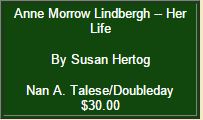‘Anne Morrow Lindbergh — Her Life’ by Susan Hertog
Anne Lindbergh struggled to balance family and ambition
By Rebecca Redshaw
Reprinted from the Pittsburgh Post-Gazette
 Sunday, February 06, 2000
Sunday, February 06, 2000
Most of us will never know the kind of devastation coupled with fame Anne Morrow Lindbergh experienced in her life. With the possible exception of John F. Kennedy Jr., no Americans were ever cheered by the public or hounded by the media more than Charles Lindbergh and his wife.
Susan Hertog’s biography explores the thoughts of a woman who reflects upon the conflicts of women of her generation.
The meticulously footnoted book is divided into three sections — Anne’s early years before marrying the already famous aviator and their first years of marriage, the kidnapping of their 20-month-old son and the ensuing traumatic years, and finally, the war years and how politics affected her marriage.
It may be hard to relate to the decisions that tormented the young Anne Morrow. Born into a family of prominence (her father was ambassador to Mexico), her biggest dilemma seemed to be living up to the feminine standards set by her mother and embodied by her sister, Elizabeth.
Taken by surprise when Charles Lindbergh chose her to be his wife, Anne labored over the decision for months. It is apparent early on that there are no easy decisions for this woman. In the manner of the day, she turned to writing as an outlet for her emotions, keeping detailed journals that expressed her feelings.
As Charles’ wife, she not only traveled with him around the world, she became an accomplished pilot, keeping records and navigating. The couple traveled extensively in the early years of their marriage, public adulation meeting their every landing.
The kidnapping of her son forever changed Anne’s life. Hertog reconstructs not only the crime scene but the family dynamics, including the servants, with such detail it leaves the reader to wonder how the “Trial of the Century” could have been handled more ineptly.
Anne Lindbergh was 25 when her son was murdered and had lived not even a third of her life. Over the years, she struggled constantly with how to be a good wife to Charles and mother to her five children and still be a person in her own right.
Hertog notes, “The problems confronting the ambitious woman weighed heavily on Anne’s mind. She could not be the most important person in her children’s lives and still manage to write and spend time with Charles. Life itself was her art. If only she could be everything to everyone.”
This theme is drummed home throughout Hertog’s book.
And yet Anne did write and publish successfully. Her most famous book, “Gift from the Sea,” is a sensitive, insightful work published in 1955 that withstands the test of time.
The most revealing and upsetting aspect of this biography is Anne’s inability to speak out about the injustices of World War II. For fear of appearing to be a disloyal wife, she stood silently by her husband who opposed the United States’ involvement in the conflict until Pearl Harbor.
When reading nonfiction, the reader must be conscious of what is in fact “fact.” As tempting as it may be to write, as Hertog does, “Perhaps Charles wondered whether Anne … had betrayed him, or whether… she had sacrificed herself to preserve their tarnished marriage. Perhaps he even questioned his moral standards and wondered whether he could play according to Anne’s rules,” it is not fair to the subjects to speculate on their thoughts.
Hertog need not have bothered. “Anne Morrow Lindbergh — Her Life” is intriguing without conjecture.